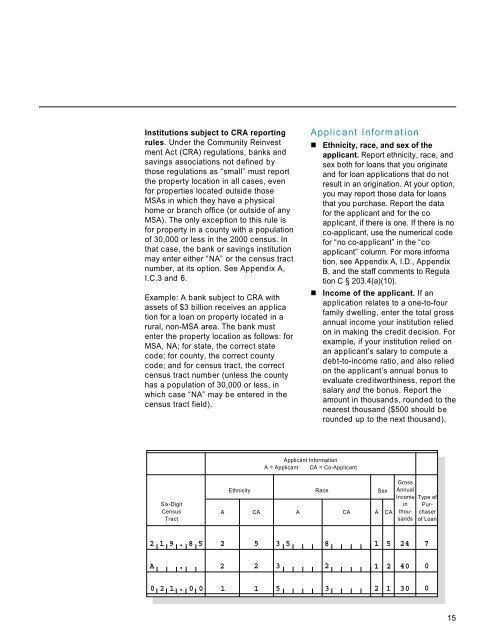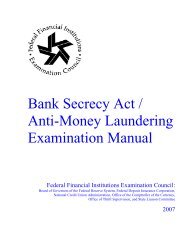A Guide to HMDA Reporting - ffiec
A Guide to HMDA Reporting - ffiec
A Guide to HMDA Reporting - ffiec
You also want an ePaper? Increase the reach of your titles
YUMPU automatically turns print PDFs into web optimized ePapers that Google loves.
Institutions subject <strong>to</strong> CRA reporting<br />
rules. Under the Community Reinvestment<br />
Act (CRA) regulations, banks and<br />
savings associations not defined by<br />
those regulations as “small” must report<br />
the property location in all cases, even<br />
for properties located outside those<br />
MSAs in which they have a physical<br />
home or branch office (or outside of any<br />
MSA). The only exception <strong>to</strong> this rule is<br />
for property in a county with a population<br />
of 30,000 or less in the 2000 census. In<br />
that case, the bank or savings institution<br />
may enter either “NA” or the census tract<br />
number, at its option. See Appendix A,<br />
I.C.3 and 6.<br />
Example: A bank subject <strong>to</strong> CRA with<br />
assets of $3 billion receives an application<br />
for a loan on property located in a<br />
rural, non-MSA area. The bank must<br />
enter the property location as follows: for<br />
MSA, NA; for state, the correct state<br />
code; for county, the correct county<br />
code; and for census tract, the correct<br />
census tract number (unless the county<br />
has a population of 30,000 or less, in<br />
which case “NA” may be entered in the<br />
census tract field).<br />
Applicant Information<br />
A = Applicant CA = Co-Applicant<br />
Applicant Information<br />
¢ Ethnicity, race, and sex of the<br />
applicant. Report ethnicity, race, and<br />
sex both for loans that you originate<br />
and for loan applications that do not<br />
result in an origination. At your option,<br />
you may report those data for loans<br />
that you purchase. Report the data<br />
for the applicant and for the coapplicant,<br />
if there is one. If there is no<br />
co-applicant, use the numerical code<br />
for “no co-applicant” in the “coapplicant”<br />
column. For more information,<br />
see Appendix A, I.D., Appendix<br />
B, and the staff comments <strong>to</strong> Regulation<br />
C § 203.4(a)(10).<br />
¢ Income of the applicant. If an<br />
application relates <strong>to</strong> a one-<strong>to</strong>-fourfamily<br />
dwelling, enter the <strong>to</strong>tal gross<br />
annual income your institution relied<br />
on in making the credit decision. For<br />
example, if your institution relied on<br />
an applicant’s salary <strong>to</strong> compute a<br />
debt-<strong>to</strong>-income ratio, and also relied<br />
on the applicant’s annual bonus <strong>to</strong><br />
evaluate creditworthiness, report the<br />
salary and the bonus. Report the<br />
amount in thousands, rounded <strong>to</strong> the<br />
nearest thousand ($500 should be<br />
rounded up <strong>to</strong> the next thousand).<br />
Ethnicity Race Sex<br />
Six-Digit<br />
Census A CA A CA A CA<br />
Tract<br />
Gross<br />
Annual<br />
Income<br />
in<br />
thousands<br />
4 2 1 9 . 8 5 2 5 3 5 8 1 5 24 7<br />
N A . 2 2 3 2 1 2 40 0<br />
0 0 2 1 . 0 0 1 1 5 3 2 1 30 0<br />
Type of<br />
Purchaser<br />
of Loan<br />
15
















